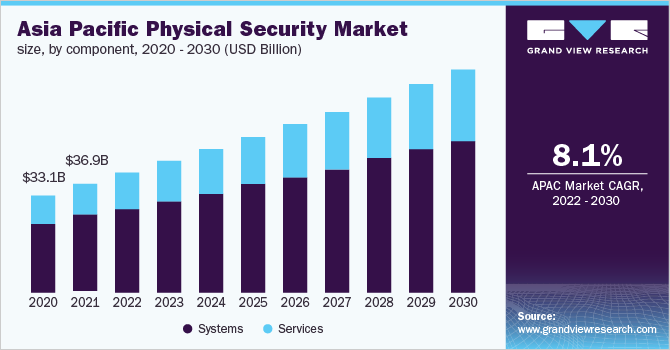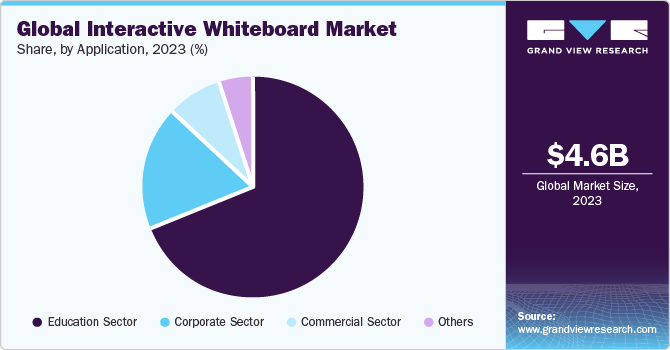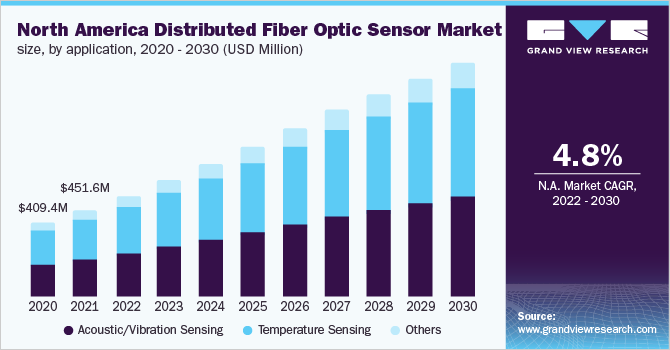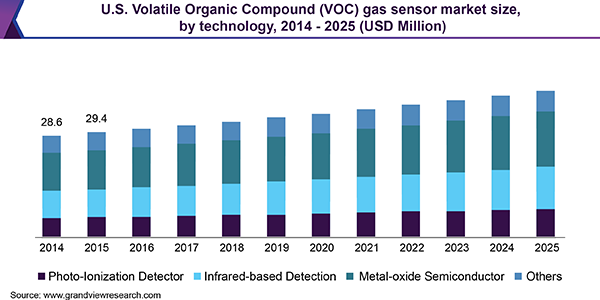
The global physical security market is expected to reach USD 203.05 billion by 2030, growing at a CAGR of 6.1% according to a new study by Grand View Research, Inc. lack of physical security leads to higher rates of burglaries and thefts. Therefore, safeguarding the physical perimeter and individual assets, including expensive technological equipment, has gained importance and is driving the market growth. Increasing awareness about securing the perimeter in developing economies has led to a rise in deployment of IP-based cameras in residential societies as well as commercial complexes and offices.
Furthermore, increasing terror threats, border disputes, and refugee crises drive the adoption of stringent safety measures, thereby driving the physical security market growth. For instance, in February 2022, Hangzhou Hikvision Digital Technology Co., Ltd, the world's prominent manufacturer of innovative video surveillance systems and solutions, introduced the TandemVu PTZ camera line, which combines PTZ and bullet camera capabilities into a single unit. These cameras can monitor broad regions and zoom in on individual security incidents while simultaneously maintaining attention on both viewpoints. Further, this camera would be deployed in commercial complexes and residential societies to reduce terror threats and adopt more physical security on the premises.
Physical Security Market Segmentation
Grand View Research has segmented the global physical security market report on the basis of component, organizational size, end-user and region:
Based on the Component Insights, the market is segmented into Systems, Services.
- The systems segment led the market in 2021 and accounted for a share of over 65.00% of the global revenue.
- The segment is further categorized into Physical Access Control Systems (PACS), video surveillance systems, perimeter intrusion detection and prevention, Physical Security Information Management (PSIM), Physical Identity And Access Management (PIAM), and fire & life safety. The video surveillance system sub-segment dominated the systems market in 2021. The system included in video surveillance systems is analog cameras, axis network cameras, video encoders, monitors, and storage solutions.
- Technological advancements, such as UHD, coupled with decreasing cost of equipment, have led to increased adoption of video surveillance systems to enhance remote monitoring and physical security.
- This would improve existing security systems by adding a layer of awareness to detect future threats ahead of time. The services component segment is expected to grow at the fastest CAGR over the forecast period.
- Services comprise deployment, maintenance, and updating of equipment as well as software, which further improves performance by providing the user with optimum control of the complete security infrastructure.
- The sub-segments of services include system integration, remote monitoring, and others. Driven by factors, such as changing approach of customers toward security operations, demand for cost-effective physical security systems, stringent regulatory compliance, and rapid growth of enterprises, system integration led the services segment in 2021.
Based on the Organization Size Insights, the market is segmented into SMEs, Large Enterprises.
- The SMEs segment is anticipated to witness the fastest CAGR of 8.2% over the forecast period. The segment growth can be attributed to theft, environmental dangers, and intruders, as small businesses also have a lot of resources and people to protect.
- The large enterprise segment is also anticipated to register a significant CAGR over the forecast period. The segment is driven by the factors, such as more significant infrastructure to safeguard, highly critical information to protect, and greater revenue to spend.
- Furthermore, protecting their data from thefts, cyberattacks, and unauthorized access lets the segment shift towards physical security solutions. Cyber threats are most likely to target businesses that store essential personal and sensitive information. These threats further result in financial losses, information security, and data breaches.
- The PBAC connects to a cloud authorization service and enables businesses to quickly develop dynamic permission for employees to access facilities and protect their highly critical information from cyber-attacks or thefts.
Based on the End-user Insights, the market is segmented into Transportation, Government, Banking & Finance, Utility & Energy, Residential, Industrial, Retail, Commercial, Hospitality, Others.
- The residential segment is projected to register the highest CAGR of 6.9% over the forecast period due to the high number of damages caused to assets and resources during thefts and other attacks. Application in residential properties has enhanced user experience along with protecting assets from any potential risks.
- The growth is attributed to the development of smart homes coupled with the increased use of advanced video surveillance and access control systems.
- Moreover, remote monitoring through cloud-based services has made it easier to supervise and control the physical environment. Transportation is projected to be the second-fastest-growing end-user segment over the forecast period.
- Over the past few years, several industries & sectors, such as BFSI, residential, government, and transportation, have witnessed several cases of security breaches. These factors are expected to drive the demand for physical security systems.
Physical Security Regional Outlook
- North America
- Europe
- Asia Pacific
- South America
- Middle East & Africa (MEA)
Key Companies Profile & Market Share Insights
Market leaders focus on providing diverse solutions to cater to various applications to gain a higher market share. Companies also focus on strategic alliances, mergers, and acquisitions to enhance their product offerings and improve their market share.
Some prominent players in the global physical security market include:
- Hangzhou Hikvision Digital Technology Co., Ltd.
- Honeywell International, Inc.
- Genetec, Inc.
- Cisco Systems, Inc.
- Axis Communications AB
- Pelco
- Robert Bosch GmbH
- Johnson Controls
- ADT LLC
Order a free sample PDF of the Physical Security Market Intelligence Study, published by Grand View Research.
About Grand View Research
Grand View Research, U.S.-based market research and consulting company, provides syndicated as well as customized research reports and consulting services. Registered in California and headquartered in San Francisco, the company comprises over 425 analysts and consultants, adding more than 1200 market research reports to its vast database each year. These reports offer in-depth analysis on 46 industries across 25 major countries worldwide. With the help of an interactive market intelligence platform, Grand View Research Helps Fortune 500 companies and renowned academic institutes understand the global and regional business environment and gauge the opportunities that lie ahead.


